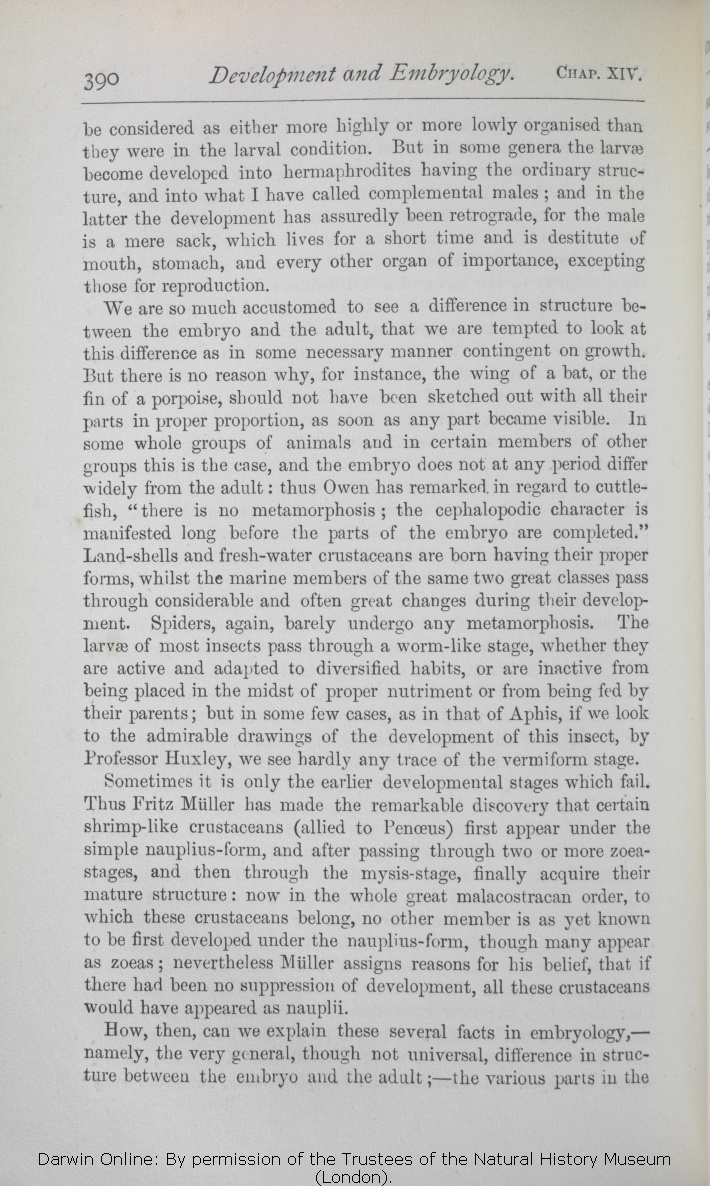be considered as either more highly or more lowly organised than they were in the larval condition. But in some genera the larvæ become developed
..| ..... 1872 | | either 1859 1860 1861 1866 1869 |
| and 1872 | | or 1859 1860 1861 1866 1869 |
| males; 1872 | | males: 1859 1860 | | males, 1861 1866 1869 |
| latter 1872 | | latter, 1859 1860 1861 1866 1869 |
| retrograde, 1872 | | retrograde; 1859 1860 1861 1866 1869 |
| time 1872 | | time, 1859 1860 1861 1866 1869 |
| and every 1872 | | or 1859 1860 1861 1866 1869 |
| organ 1859 1860 1861 1866 1872 | | organs 1869 |
| those for 1869 1872 | | for 1859 1860 1861 1866 |
|
|
We are so much accustomed to see
a difference | a difference 1869 1872 | | differences 1859 1860 1861 1866 |
| OMIT 1869 1872 |
| and likewise a close similarity in the embryos of widely different animals within the same class, 1859 1860 |
| and like-wise a close similarity in the embryos of widely different animals within the same class, 1861 |
| and like-wise a close similarity in the embryos of different animals within the same class, 1866 |
| are tempted 1869 1872 |
| might be led 1859 1860 1861 1866 |
| this difference as in some necessary manner contingent 1872 |
| these facts as necessarily contingent in some manner 1859 1860 1861 |
| these facts as in some manner necessarily contingent 1866 |
| this difference as in some manner 1869 |
| on 1859 1860 1861 1866 1872 |
| necessarily contingent on 1869 |
| ..... 1869 1872 | | obvious 1859 1860 1861 1866 |
| wing 1859 1860 1861 1866 1872 | | wings 1869 |
| fin 1859 1860 1861 1866 1872 | | fins 1869 |
| their 1869 1872 | | the 1859 1860 1861 1866 |
| part 1872 | | structure 1859 1860 1861 1866 1869 |
| visible. 1869 1872 | | visible 1859 1860 1861 1866 |
| ..... 1869 1872 | | in 1859 1860 1861 1866 |
| ..... 1869 1872 | | the 1859 1860 1861 1866 |
| ..... 1869 1872 | | embryo. 1859 1860 1861 1866 |
| 1 blocks not present in 1872; present in 1859 1860 1861 1866 1869 | | And in
some whole groups of animals and in certain members of other groups,
the
embryo does not at any period differ widely from the adult: thus Owen has remarked in regard to cuttle-fish, "there is no metamorphosis; the cephalopodic character is manifested long before the parts of the embryo are completed;"
and again in spiders, "there is nothing worthy to be called a metamorphosis."
|
| The larvæ of most insects pass through a worm-like stage, whether they are active and 1869 1872 |
| The larvæ of insects, whether 1859 1860 1861 |
| With almost all insects, the larvæ, whether 1866 |
| diversified 1869 1872 |
| the most diverse and active 1859 1860 1861 |
| diversified and active 1866 |
| are 1869 1872 | | quite 1859 1860 1861 | | remaining 1866 |
| inactive 1869 1872 | | inactive, 1859 1860 1861 1866 |
| from being placed in the midst of proper nutriment 1869 1872 |
| being fed by their parents or placed in the midst of proper nutriment, 1859 1860 1861 |
| being placed in the midst of proper nutriment or fed by their parents, 1866 |
| or from being fed by their parents; 1869 1872 |
| yet nearly all pass through a similar worm-like stage of development; 1859 1860 1861 1866 |
| of the development of this insect, by Professor Huxley, 1869 1872 |
| by Professor Huxley of the development of this insect, 1859 1860 1861 1866 |
| hardly any 1866 1869 1872 | | no 1859 1860 1861 |
|
|
Sometimes | Sometimes 1869 1872 |
| In some cases 1866 |
| fail. 1869 1872 | | fail; 1866 |
| ..... 1869 1872 | | these 1866 |
| ..... 1869 1872 | | apparently 1866 |
| ..... 1869 1872 | | having 1866 |
| ..... 1869 1872 | | suppressed. 1866 |
| Müller 1872 | | Müller 1866 1869 |
| ..... 1869 1872 | | recently 1866 |
| after passing 1869 1872 | | passing 1866 |
| then through the 1869 1872 |
| through the 1866 |
| great 1869 1872 | | enormous 1866 |
| order, 1872 | | class, 1866 1869 |
| Müller 1872 | | Müller 1866 1869 |
| belief, 1872 | | belief 1866 1869 |
| there 1872 | | these 1866 1869 |
| OMIT 1872 |
| crustaceans would have appeared as nauplii, if there 1866 1869 |
| development, all these crustaceans would have appeared as nauplii. 1872 |
| development;— or that they were primordially developed under this form. 1866 |
| development. 1869 |
|
|
How, then, can we explain these several facts in embryology,—
namely, | namely, 1866 1869 1872 | | namely 1859 1860 1861 |
| though 1869 1872 | | but 1859 1860 1861 1866 |
| universal, 1866 1869 1872 | | universal 1859 1860 1861 |
| the various 1869 1872 | | of 1859 1860 1861 1866 |
|









